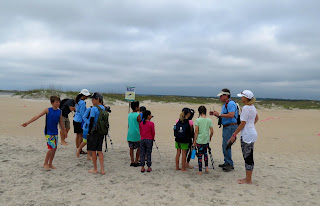Our Wrightsville Beach South End nesting colony has been facing extreme challenges this year as a result of the dredge project removal of last year’s nesting area and predation by crows and gulls. Nesting has been delayed because of consistent disturbance, but the birds are very committed to successfully nesting this year and continue to persevere.
Lindsay Addison, our friend and Coastal Biologist for Audubon NC conducted a nest check on Tuesday night (5/29) and here are the latest results…

The Common Terns have already lost two nests to avian predation (probably crows). We now have three Common Tern nests. Our most visible Common Tern nest is on the top of the dune right in the middle of the sandy opening between the dunes at the inlet as you look into the posting from the string.
 |
| photos by Mary-Ann Walton |
Our three American Oystercatcher nests that were right around hatching appear to have failed. Avian predation is exacerbated by disturbance because when adults are flushed, crows or gulls will take the opportunity to come in and grab eggs or young chicks. We thought one of the nests had hatched a chick, but we have not seen an adult Oystercatcher returning to the nesting colony with food for the chick. If you notice an Oystercatcher returning to the colony with food, please let us know right away!
 |
| photos by Mary-Ann Walton |
The Black Skimmer nesting was a little delayed this year, likely due to the changes to their habitat, and we don’t want disturbance to delay them further. As a result, we are working hard to minimize disturbance to the colony. Black Skimmers have just started laying eggs, so incubation will last approximately three weeks. Lindsay counted approximately 25 nests so far on Tuesday and marked 12 nests to monitor productivity. So far, our high count of adult Black Skimmers is 246, so it will again be one of the larger colonies in the state.
Least Terns are not nesting on the South End this year but a nice nesting colony is easily viewed and photographed on the north end of Wrightsville Beach by the Shell Island Resort and Mason Inlet.




















































